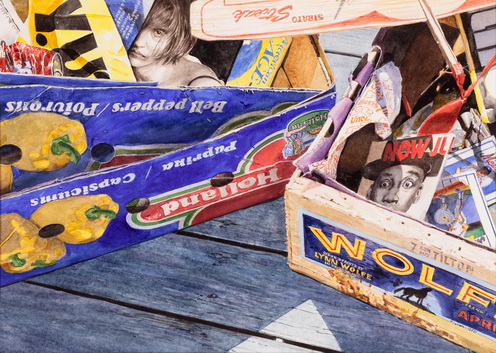Acquisition Number: 2024.1
Medium:
Watercolor on paper
Size:
18 x 24 3/4 in.
Date:
1991
Credit: Purchased by the Canton Museum of Art
From the late 1960s on, Idelle Weber began depicting hyperrealistic arrangements of trash as seen here in “East End - Wolf.” Produce boxes containing various objects such as baseball cards, magazine advertisements, and other discarded items fill the top of the composition. Though seemingly random and haphazard looking, these scenes were intentionally chosen. Weber would walk the city of New York seeking out the perfect arrangement of these abandoned goods, sometimes spending months in her search. She said:
“What I look for in the world are groupings of graphic images, objects with complex sculptural shapes, flat and curved planes, and printed matter. The printed word for me is practically an icon. I carefully render all the language, even the incomplete words I find. But, equally important are the formal values: the textures, light, and compelling color relationships. I am very very very fussy…and when I do find something to use, I know it instantly.”
Idelle Weber's trash paintings are influenced by her Pop art era with their utilization of text and graphics in product advertising to reflect consumerism. Brands such as Strato Streak, Holland, and Uncle Ben’s have legible lettering in “East End-Wolf.” Weber also employed the Pop art strategy of using bright, contrasting colors to catch the viewer’s attention from a distance, creating a visually striking impact that’s a little unsettling with its clash of hues.
Like each one of her photorealist trash paintings, “East End - Wolf” is painted in painstaking detail. The edges of the Holland boxes are visibly worn, their sides creased. The partial portrait of the woman in the box captures each single strand of hair on her head as well as haggard lines on her face. The closely-cropped aerial vantage point forces us to look directly down onto the scene, confronting the items we tend to disregard — soda pop cans, mail, food wrappers. Weber boldly defied the notion that still lifes had to be idealized depictions of objects of value. Rather, the objects chosen could be the everyday discarded ones that we ignore, worthy of exploring closely and regarding as beautiful. Through her work, Weber challenged viewers to reconsider their relationship with everyday objects.
|
